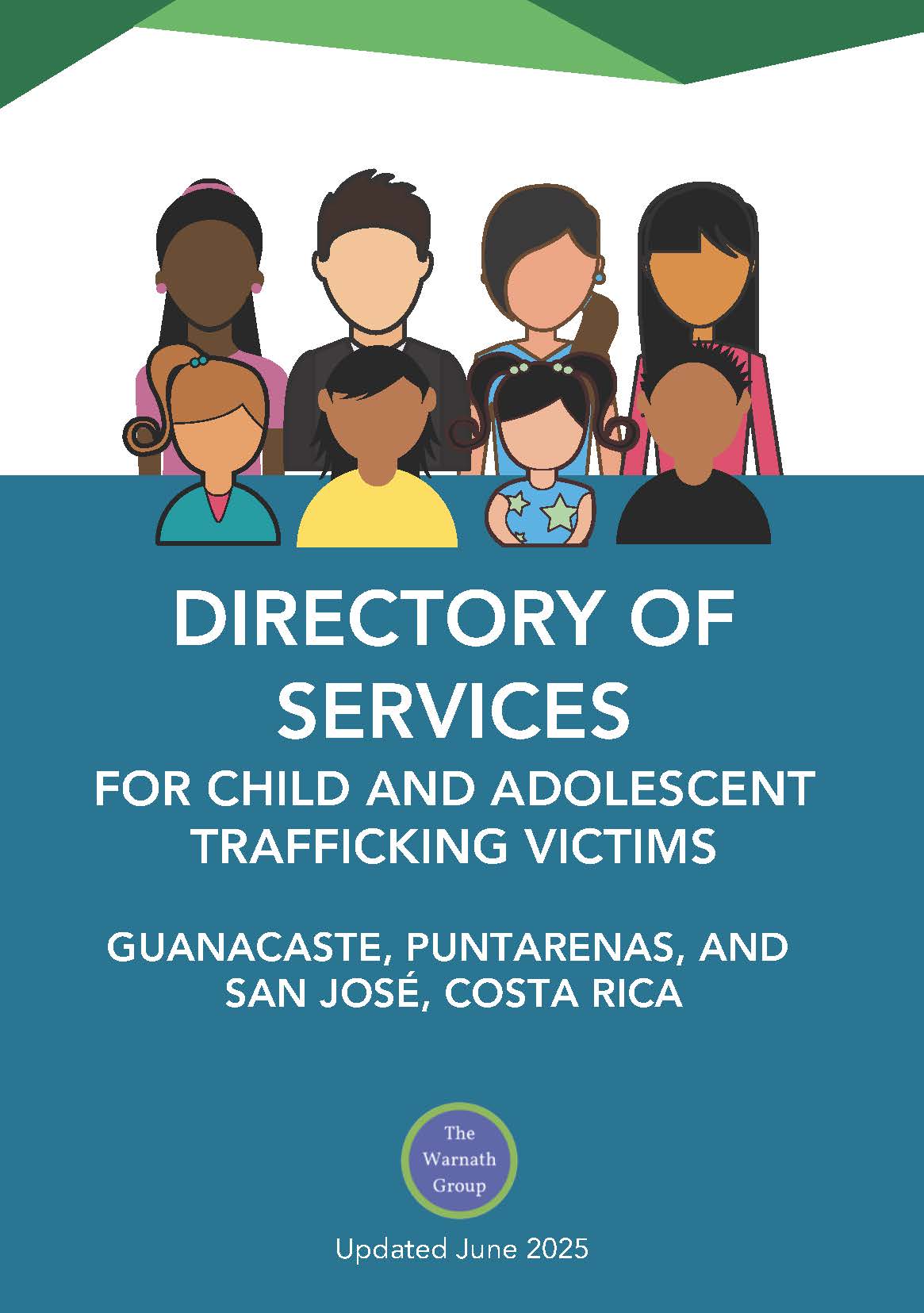Directory of Services
What is the Directory of Services?
The Warnath Group is pleased to have partnered with the U.S. and Costa Rica governments to develop the Directory of Services for Trafficking Victims: A Tool for Practitioners in Costa Rica. This Directory of Services is a resource for practitioners to use in their daily work when they encounter possible trafficking victims. It provides information about:
-
- trafficking in persons in Costa Rica
- how to preliminarily identify and refer possible trafficking victims for protection and assistance
- services available for trafficking victims and their families and how to contact service providers in Guanacaste, Puntarenas, and San José
The Directory of Services provides critical information on how practitioners can preliminarily identify and refer a trafficking victim for protection and assistance, including formal accreditation through the CONATT Immediate Response Team (ERI), as well as how to report and refer potential trafficking situations for investigation by FACTRA. In addition, the Directory of Services offers information about and examples of trafficking in persons in Costa Rica and answers to frequently asked questions to equip practitioners to recognize and respond to when they encounter possible trafficking victims. This resource puts this important and life-saving information into the hands of practitioners who are at the frontline of combatting trafficking in persons in Costa Rica.
The service providers included in this Directory of Services were validated in partnership with CONACOES. The Warnath Group would like to thank the Government of Costa Rica institutions and non-governmental organizations who participated in the creation of this resource for their collaboration.
What is the Map of Available Services?
All trafficking victims in Costa Rica have the right to be protected and receive help. The IACT Program created a map of available services for trafficking victims in Guanacaste, Puntarenas, and San José, Costa Rica (updated as of September 2025).
In addition to being listed in the Directory of Services, contact information for service providers can be found on the accompanying Map of Available Services for Trafficking Victims in Guanacaste, Puntarenas, and San José. Please click on the expand button ![]() to access the map.
to access the map.
How do you access the Map of Available Services?
You can always access the Map of Available Services by clicking the link below. When you click the link below, a new tab will open in your web browser and you will be directed to the Map of Available Services via Google Maps: https://www.google.com/maps/d/u/0/viewer?mid=1QCdTSL2k6xP3zEJqtDNrYz4SDk99Vwk&femb=1&ll=9.633440559599258%2C-84.32992300000001&z=8 ![]() .
.
Who is the Map of Available Services for?
This map is for practitioners who, through their day-to-day work, may come into contact with possible trafficking victims. It can also be used by anyone who may know or suspect that a person has been trafficked and needs protection and assistance.
How do you use the Map of Available Services?
As a viewer of the map, you may choose between two base maps upon which the layers rest. The default base layer is the lightly shaded political map. To change this: First, make sure the map legend is open by clicking “map legend” in the top left of the screen. With the map legend open, navigate to the bottom left of the screen and click on the miniature map in the bottom-left corner of the screen.
As a viewer of the map, you can also choose which layers to display on the base map. Again, make sure the map legend is open. Next, check the box to left of the name of the layer. You may display any number of layers at one time.
If you check a layer, you will then see a list of all the corresponding offices for that layer. Click on “more” to see all the offices if necessary. You may click on an office on the map legend or on the map itself. Doing so will provide you with details about the office on the left side of the screen. Click the back arrow on the left side of the screen to return.
You may collapse the map legend at any time by clicking on the three dots arranged vertically on the map legend, and clicking “collapse map legend.”
The Directory of Services for Child and Adolescent Trafficking Victims
Warnath Group has also created a version of the Directory of Services specifically for children and adolescents. The Directory of Services for Child and Adolescent Trafficking Victims:
-
- explains what child and adolescent trafficking is, including examples and stories to support learning
- describes the help that trafficking victims and their families can receive in Costa Rica
- provides contact information for service providers in Guanacaste, Puntarenas, and San José
Directory of Services for Trafficking Victims
IACT created this version of the Directory of Services tailored for adult trafficking victims so that they can learn about trafficking in persons, the rights and entitlements of trafficking victims, and where to seek help for themselves or someone they know. Practitioners can share this version directly with possible trafficking victims so that they have the information they need to receive assistance and protection.
The Practitioner Platform
The IACT Program has created specialized resources and tools for practitioners to use in the protection of trafficking victims, the prosecution of trafficking crimes, and the prevention of trafficking in persons.

Developed by and © 2025 Warnath Group, LLC ![]() . All Rights Reserved.
. All Rights Reserved.
The development of the IACT Learning Hub was funded through a cooperative agreement with the U.S. Department of State. The opinions, findings, and conclusions stated herein are those of the developers and do not necessarily reflect those of the U.S. Department of State.
Sitemap • Privacy Policy • Terms of Use • About the IACT Program ![]()


